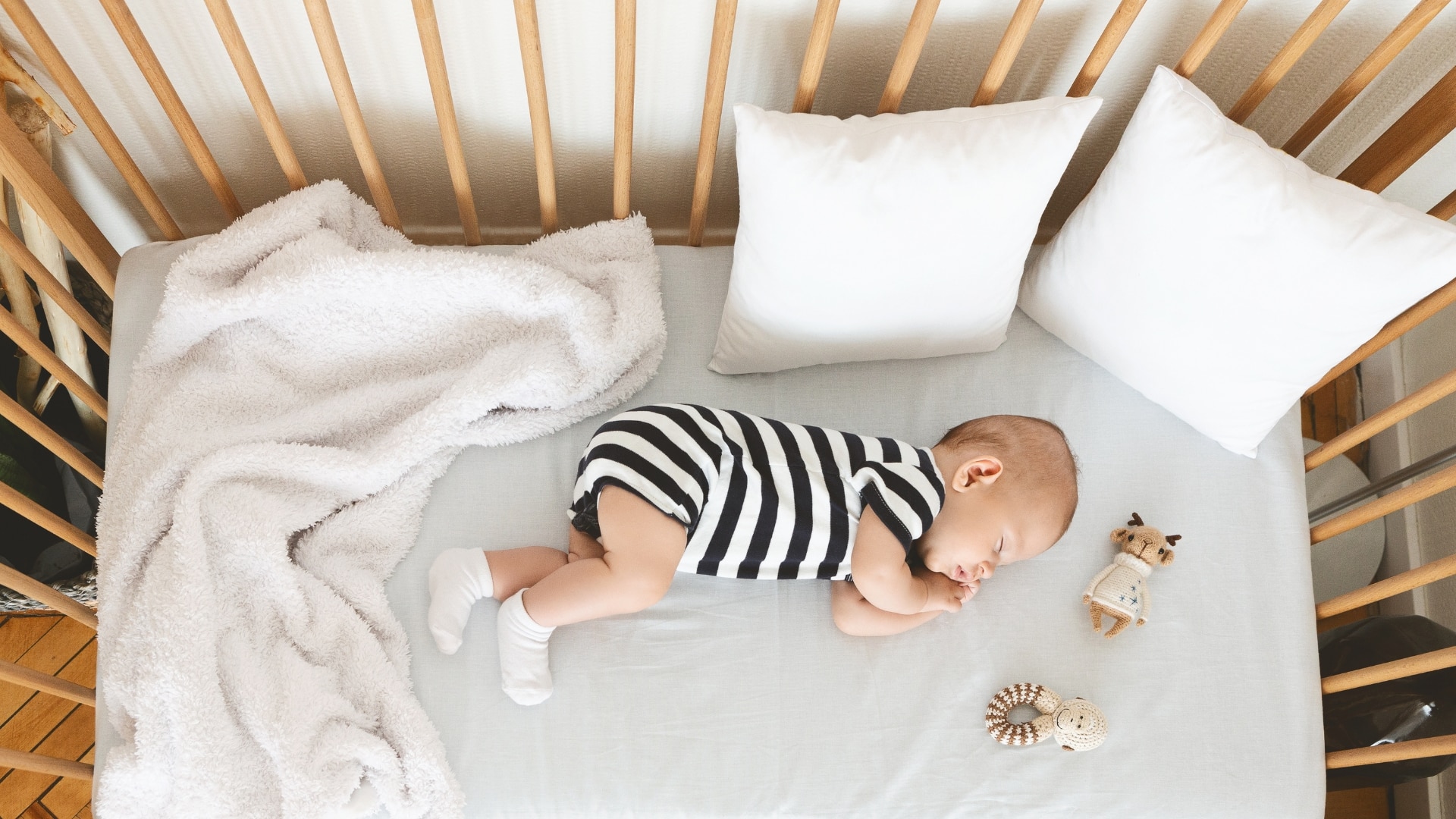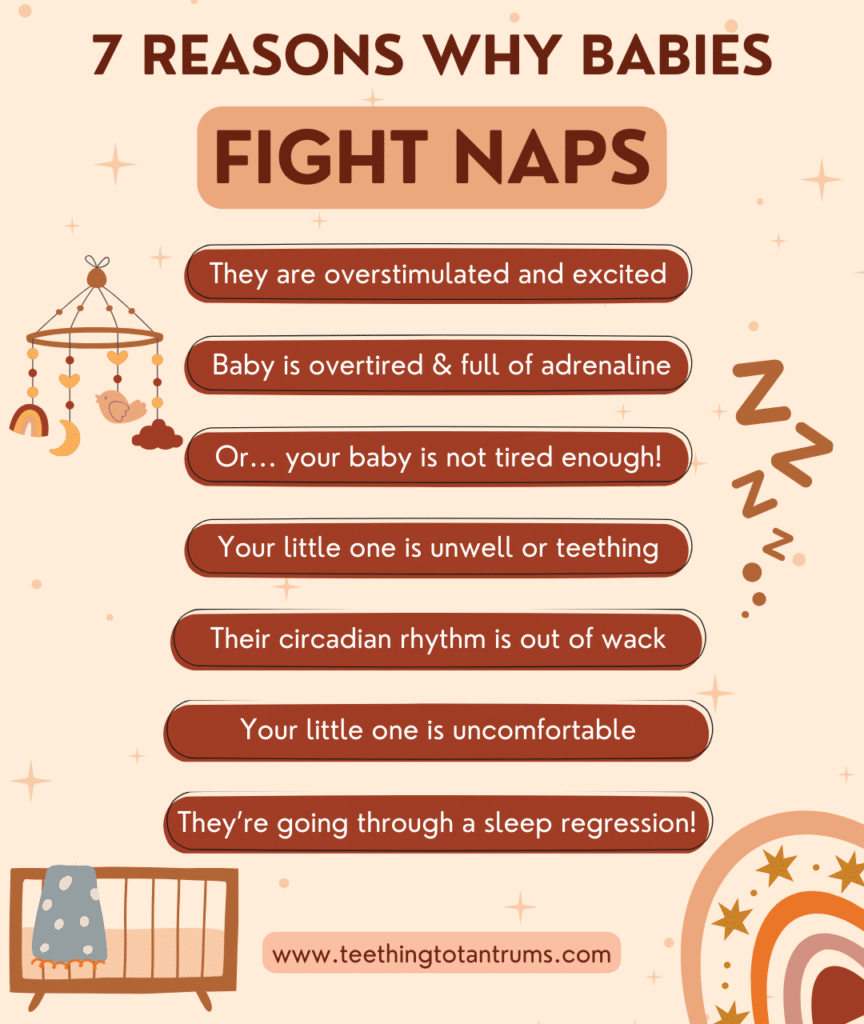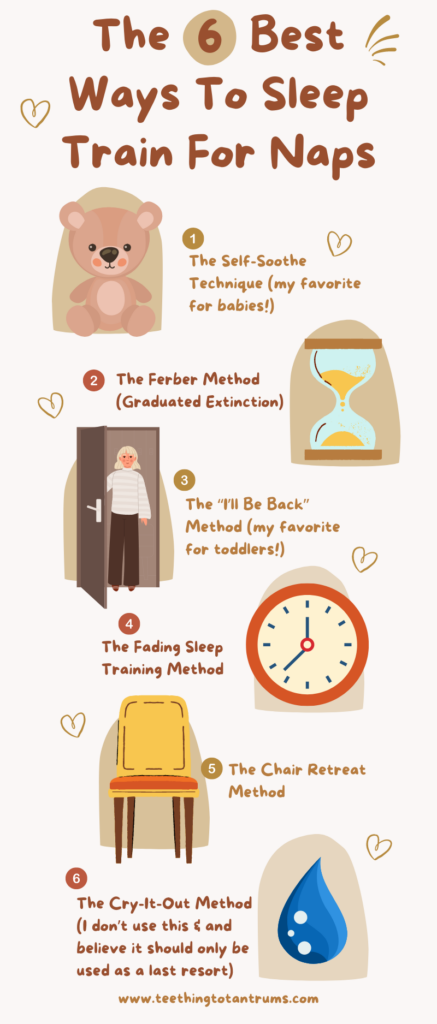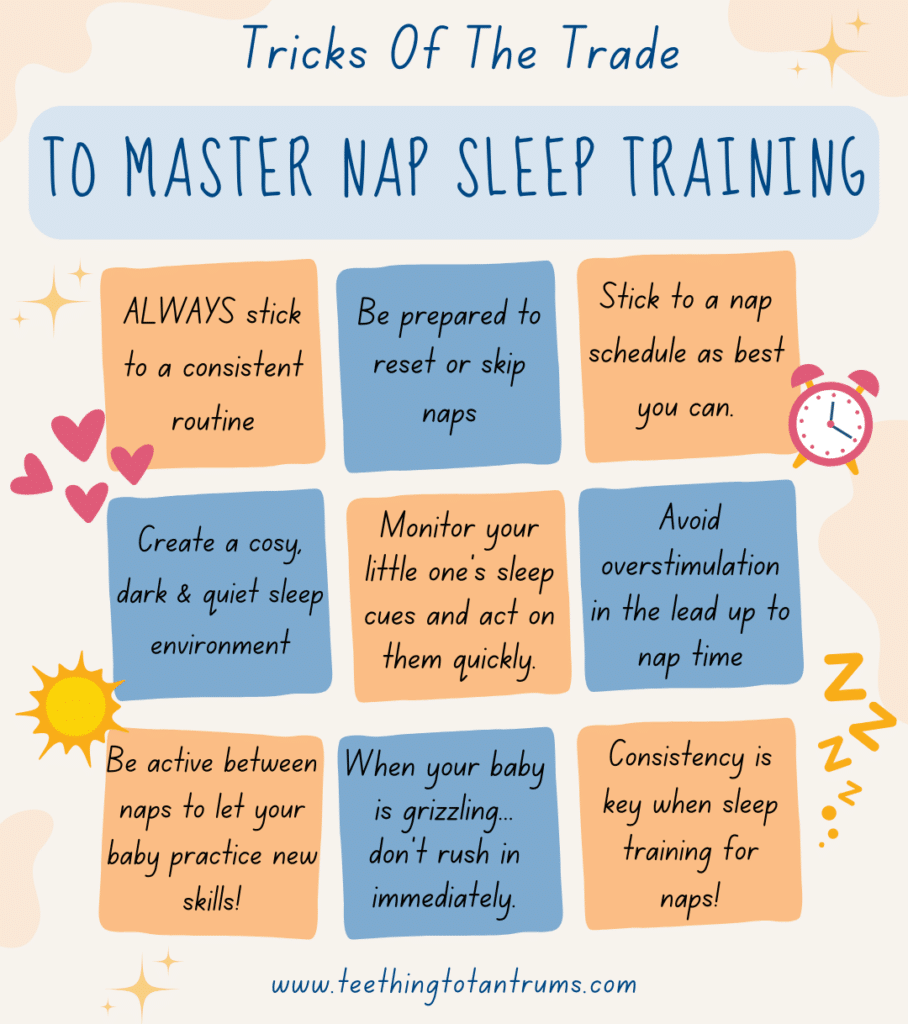Sleep training is one of the most common ways you can help your little one fall asleep quickly and peacefully at night. However, there’s a lesser-known side to sleep training… And that’s sleep training for naps.
But how does it work? What do we need to change? Is it easy to implement?
Luckily, you’re in the right place. Here’s all you need to know about sleep training for naps.

Table of Contents
Key Takeaways
- Consistency is key when it comes to sleep training for naps. Establishing a regular nap routine and schedule will help prepare your child for nap time and teach them healthy sleep habits.
- Monitor your child’s sleep cues closely and be quick to respond to these signs to avoid overtiredness. Allowing a child to become overtired makes it much harder to get them to settle and stay asleep (both for naps and night sleep).
- There are various gentle sleep training methods you can try for naps before considering any cry-it-out approaches. Methods like the fading technique, pick-up-put-down, and chair method are good options to try for naps first.
What Is Sleep Training?
Sleep training is a term used to describe methods of teaching your baby or toddler to fall asleep and stay asleep independently. There are a range of approaches to choose from designed to help children who are at least 4 months old learn to soothe themselves to sleep.
How I Approach Sleep Training
Now, before we begin I must clarify a few things.
Firstly, I believe that sleep training is not just about implementing certain methods to get your child to sleep…
Instead, it is about approaching sleep in such a way that you teach your little one to have a healthy and balanced approach to bedtime and naps, naturally.
Secondly, I teach parents that conventional sleep training methods are only used as a last resort after having a calming evening, practicing a consistent bedtime routine, and creating a calming sleep environment.
Sleep training of any kind can be used for both naptime and nighttime sleep, but it’s important to note that sleep training during naps is a separate event from sleep training at night depending on your child’s age, developmental stage, and temperament.
On a final note, research into sleep training is often vague and inconclusive since, in most cases, the perception of what is regarded as “good sleep” and “bad sleep” in infants and toddlers is based on their parents’ perception of how much sleep they are getting and how that impacts on their mental health.
However, I still believe certain sleep training methods have their place in teaching your little one independent sleep habits.
If you are happy with the way your little one is sleeping then I would say there is no need for intervention or sleep training…
As long as you are aware that not teaching your little one to sleep independently can result in you having to help your child fall asleep and stay asleep for years to come.
Ok, with that being said, let’s get into understanding why children fight daytime sleep and how sleep training for naps can help.
Reasons Why Babies Fight Naps
Before considering nap sleep training you should always consider why your little one is fighting sleep during the day as this will help you choose the best course of action to fix daytime sleep.
Sometimes adjusting one key thing in your daily routine can fix nap issues without the need for conventional sleep training!
Here are some common reasons your baby’s nap times might not be going well:

- Overstimulated: In the lead-up to nap time, you need to wind things down with a calming activity such as reading a book or doing a puzzle. If your little one is overstimulated they will struggle to fall asleep and stay asleep. Having a consistent calming pre-nap routine will help a lot too.
- Overtired: Contrary to popular belief, an overtired baby or toddler is almost impossible to settle and will certainly not stay asleep for long. So watch for sleep cues and act promptly to avoid overtiredness.
- Not tired enough: On the other hand, babies and young children need to be tired enough to sleep so you must ensure that your little one has had a good amount of age-appropriate play time, physical activity, and stimulation throughout the day.
- Unwell or teething: If your little one is unwell or teething, be prepared for disrupted sleep during the day and the night. Do not attempt to sleep train during these times. Instead, offer lots of cuddles and comfort to help your baby get back to normal.
- Lack of fresh air and natural daylight when awake: Getting outside into the fresh air and natural light every day will regulate your little one’s circadian rhythm and increase your chances of settling into a healthy sleep routine.
- Discomfort: Ensuring your little one is comfortable when they sleep is key to them settling. Put them down with a clean diaper, and make sure your baby is well-fed and wearing appropriate sleepwear for the temperature. Daylight can disrupt nap times so using black-out blinds can help your little one to settle to sleep and stay asleep.
- Sleep regression: A sleep regression can occur at any age and be triggered by several things from developmental milestones, teething, or a change in routine such as going on holiday or moving house. A regression may disrupt nap times and will need to be managed carefully. If you suspect your little one is experiencing a sleep regression take a look at one of these posts on how to manage this phase successfully.
TOP TIP: If your baby is learning a new skill such as rolling over, sitting, crawling, or pulling to stand… Ensure they have plenty of time to practice during the day so they’re not distracted from settling at nap time.
6 Sleep Training Methods For Naps
Now, we all know how important sleep is for your baby or toddler (and for you)!
So what do you do when your little one is struggling to nap during the day or establish a regular nap routine?
This is where sleep training for naps comes in.
The aim of nap sleep training can fall into two categories:
- Training that helps your little one fall asleep independently and stay asleep for the required nap time.
- Training to consolidate your little one’s naps and get them transitioning to sleep 1, 2, or 3 times a day depending on their age.
For the former, I recommend addressing daytime and nighttime sleep at the same time…
But for the latter, I would address nighttime sleep first before trying to consolidate daytime sleep.
As with any form of sleep training, there are various sleep training methods for nap time, and the one you choose will depend on your child’s age, temperament, and your parenting style.
Here are some of the most commonly used methods:

1. The Self-Soothe Technique
The self-soothe sleep method is a more subtle sleep training style and the one that I favor the most for babies and would always try first.
It involves helping your baby to fall asleep on their own without any assistance from you by putting into place a routine that gives them the best possible chance to fall asleep independently.
This means weaning off contact napping, having a consistent naptime routine, putting your baby down when they are drowsy and not fast asleep, and gradually reducing the amount of time you spend with your baby settling them.
2. Ferber Method
The Ferber method is a variation of the cry-it-out method. It involves gradually increasing the amount of time you leave your baby to cry before checking on them.
The idea is that your baby will learn to self-soothe over time. This method can be effective for some babies, but it may not work for all.
3. I’ll Be Back
The “I’ll Be Back” method is a great sleep training technique for toddlers and involves telling your little one that you need to go and do something super boring (such as laundry, cleaning, doing emails) and that you will be back to check on them in a few minutes.
You gradually increase the time you are away until on one return they are asleep. Eventually, they will fall asleep on your return.
NOTE: It’s very important for the “I’ll Be Back” sleep training technique that you return when you say you will. This will allow your child to trust what you say and feel safe when falling asleep alone.
4. The Chair Retreat
The chair retreat method involves sitting in a chair next to your baby’s crib until they fall asleep. Each night, you move the chair further away from the crib or bed until your little one can fall asleep on their own without your presence.
When sitting in your chair, try to avoid speaking or interacting with your little one. The less interesting you are, the more likely your child is to get bored and fall asleep.
TOP TIP: Whichever method you opt for I would recommend using the same method for naps and nighttime sleep to avoid confusing your little one and giving them mixed signals.
5. Gradual Retreat or Fading Method
The Gradual Retreat method involves slowly reducing the amount of comfort you provide to your baby during sleep times.
For example, you might start by holding your baby until they fall asleep, then start putting them down when they are drowsy after a short time of holding them.
Next, you can start putting them down awake and then gradually moving further away from them each night until they can fall asleep on their own.
6. The Cry It Out Method
The cry-it-out method involves leaving your baby to cry for a set amount of time before checking on them. The idea is that your baby will learn to self-soothe and fall asleep on their own.
A more intense version of the cry-it-out method is to simply leave your baby to cry it out until they exhaust themselves and go to sleep. This method can be difficult for parents to implement, and potentially harmful to a baby’s wellbeing.
Use the cry-it-out technique with great caution.
NOTE: I do not recommend using the cry-it-out method. If you want to try it, I would only use it as a last resort after you have tried all of the other techniques I’ve suggested.
Ideal Age for Sleep Training For Naps
The ideal age to start sleep training for naps is between 4 and 6 months old. This is because your baby’s brain and body are developmentally ready to learn how to self-soothe and be physically able to nap more consistently throughout the day.
It is also around the time when your baby may start to sleep through the night (except for night feeds).
If your little one is 4 months or younger, I would recommend that you wait before starting to work on any form of sleep training.
Starting too early will more than likely end in frustration.
What If My Baby Is Too Young For Sleep Training?
Young babies need love and comfort. Establishing that bond is the most important thing you can achieve in the early months.
Therefore, if your baby is too young for sleep training, you can let them spend short times in their crib while awake during the day, put them down to sleep when drowsy and not fast asleep, and establish a recognizable nap and bedtime routine.
All of these things will set the scene for healthy sleep habits later on and may mean you don’t need to sleep train your little one in the conventional sense.
Looking to get your little one to sleep quickly and effortlessly? Check out my Bedtime and Nap Cheat Sheet and master the art of making daytime naps and bedtimes as seamless as possible.
A bedtime & nap cheat sheet so good your little one will ask you to put them to bed...
Laura Williams "This is a life saver! I'm so glad I downloaded your bedtime & nap cheat sheet. My little one actually asked me to put him to bed last night! Unbelievable! Thank you so much!"
Click Here For The FREE Cheat Sheet
My Top Tips When Sleep Training For Naps
When it comes to sleep training your baby for naps, there are a few things you can do to make the process smoother and more effective. Here are some tips to help you get started:

- Establish a consistent routine: Consistency is key when it comes to any form of sleep training. Establish a naptime routine that is the same every day, so your baby knows what to expect. This can include things like a diaper change, a story, and a lullaby.
- Be prepared to reset or skip naps: Sleep training takes time and patience. Don’t expect overnight results, and be prepared for some setbacks along the way. If your baby or toddler has not fallen asleep after an hour of trying… I would suggest getting them up and trying again in 30-60 minutes. If that does not work, then give that nap a skip and try again at the next one. Any amount of sleep achieved with your little one falling asleep independently (even if it is just 20 or 30 minutes) can be treated as a success! Hopefully, by the next naptime, they will fall asleep more quickly and stay asleep for longer.
- Stick to a nap schedule: Try to stick to a nap schedule as much as possible. This will help regulate your baby’s sleep patterns and make it easier for them to fall asleep. A good sleep schedule should include two to three naps a day, depending on your baby’s age.
- Create a sleep-conducive environment: Make sure your baby’s sleep environment is conducive to sleep. This means a dark, quiet room with a comfortable temperature. You can also use a white noise machine to help drown out any distracting sounds and blackout blinds to reduce disturbing light.
- Monitor sleep cues: Sleep cues signal to us that our baby or toddler needs to sleep. Responding to these cues promptly will increase your chances of getting your little one to settle to sleep quickly.
- Avoid overstimulation in the lead-up to naps: Babies and toddlers can easily become overstimulated when they are learning about the world around them. Therefore you should aim to lower the energy levels in the lead-up to naps and have some quiet play before you start your nap routine.
- Be active between naps: Allow your little one to practice any new skills they may be learning between naps and have plenty of playtime. This will help ensure they are tired enough when nap time comes around.
- Don’t rush in: Babies often moan and grizzle while they are settling to sleep and during sleep so resist the urge to go in and pick them up at every noise. Instead, wait a few minutes and see if they resettle.
- Be consistent: Consistency is key when it comes to sleep training for naps. Stick to your routine and schedule as much as possible, even on weekends or when you’re away from home.
TOP TIP: Another way to help your baby fall asleep independently is to put them in their crib for short periods when they are not expected to sleep. Put up a crib mobile for them to watch and leave them for a short while. This allows your baby the opportunity to get used to being awake in their sleep space and comfortable being alone.
Should You Sleep Train Naps Or Nights First?
When it comes to sleep training, it’s common to wonder whether you should start with naps or nights. The answer is not straightforward, as it depends on various factors.
1. Consider Your Child’s Age
If your child is younger than six months, it’s best to focus on improving their night sleep before tackling naps. This is because young babies need to eat frequently and have shorter sleep cycles, making it harder to establish a regular nap schedule.
For babies older than six months, you can start with either naps or nights. Some parents prefer to start with naps as they are shorter and less daunting than tackling a whole night of sleep training.
2. Think About Your Goals
Consider what your ultimate goal is for sleep training your baby.
- If you want your child to be able to fall asleep independently and sleep through the night, then it may be best to start with nighttime sleep training.
- On the other hand, if you are struggling with short naps or your child is not napping at all and getting overtired which will then sabotage nighttime sleep, then I would suggest starting with nap training.
- In some cases, it may make sense to train both night and naps at the same time depending on whether you are trying to consolidate naps or just want to teach your little one to fall asleep independently no matter when they sleep.
3. Keep Consistency In Mind
Regardless of whether you start with naps or nights, or you tackle both, consistency is key.
Make sure you have a consistent sleep routine and stick to it as much as possible. This will help your child feel more secure and learn the signs that sleep time is approaching.
It’s also important to be consistent with your sleep training method. Switching back and forth between different methods can confuse your child and make sleep training more difficult.
How Long Does Sleep Training For Naps Take?
Nap sleep training can take anywhere from 2 to 3 weeks on average. However, the duration may vary depending on your child’s age, temperament, and sleep habits.
During the first few days of sleep training, your child may resist the change and take shorter naps or skip them altogether.
If this is the case, you will need to let your little one take a short cat nap and bring bedtime forward to prevent them from becoming stuck in a cycle of overtiredness.
(This may mean canceling a few plans, but it’ll be worth it in the long run)
As your child begins to adapt to the new routine, you may notice that their naps become longer and more regular. This is a sign that your sleep training efforts are paying off.
Frequently Asked Questions About Sleep Training For Naps
Looking for more information about sleep training for naps? You’re in luck! Here are the most commonly asked questions answered just for you.
Q: How long should I let my baby cry during nap training?
A: It is normal for babies to cry during nap training, but it is important to establish a limit to how long you will let them cry. If you follow the Ferber Method of sleep training, it is recommended that you start with short intervals and gradually increase them. If you’re trying a different method, you may prefer to check on your baby every few minutes to provide subtle comfort (a tummy rub or gentle pat).
Q: What are some effective nap training methods for toddlers?
A: Several nap training methods can work for toddlers, including the fading method, the pick-up-put-down method, and the chair method. It is important to choose a method that works for your family’s needs and to be consistent with the approach, so check out this post to learn more about sleep training a toddler.
Q: Can nap training work for a 5-month-old baby?
A: Yes, nap training can work for a 5-month-old baby. However, it is important to ensure that your baby is developmentally ready for nap training. Are they sleeping through the night (except for feeds)? You should also consider any medical or health issues that may be affecting your baby’s sleep.
Q: Why is sleep training for naps not working?
A: There could be several reasons why sleep training for naps is not working. It could be that your baby is not developmentally ready, they may be teething, there may be an underlying medical or health issue, or they are experiencing a sleep regression. It is important to be patient and consistent with your approach and to seek advice from a healthcare professional if necessary.
Q: At what age should I start nap training my baby?
A: There is no one-size-fits-all answer to this question, as every baby is different. However, most experts recommend waiting until your baby is around 4-6 months old before starting nap training. It is important to ensure that your baby is developmentally ready and to consult with a healthcare professional if you have any concerns.
Need More Parenting Help?
- Download our FREE Bedtime & Nap Sleep Cheat Sheet. It’s a free, easy-to-use and proven formula designed for parents of 0-5 year olds to master the art of consistently undisturbed and restful sleep without the yelling, nagging or exhausting long-winded evenings.
- Check out our Parenting Toolbox. You’ll get access to expertly-chosen products that you can guarantee are the best for your little one and your wallet.
- Are you looking for personalized guidance to navigate the challenges of parenting? I offer 1-on-1 consultations to bring you tailored strategies and actionable advice to help support your child's growth and well-being with confidence.

A bedtime & nap cheat sheet so good your little one will ask you to put them to bed...
Laura Williams "This is a life saver! I'm so glad I downloaded your bedtime & nap cheat sheet. My little one actually asked me to put him to bed last night! Unbelievable! Thank you so much!"
Click Here For The FREE Cheat Sheet


